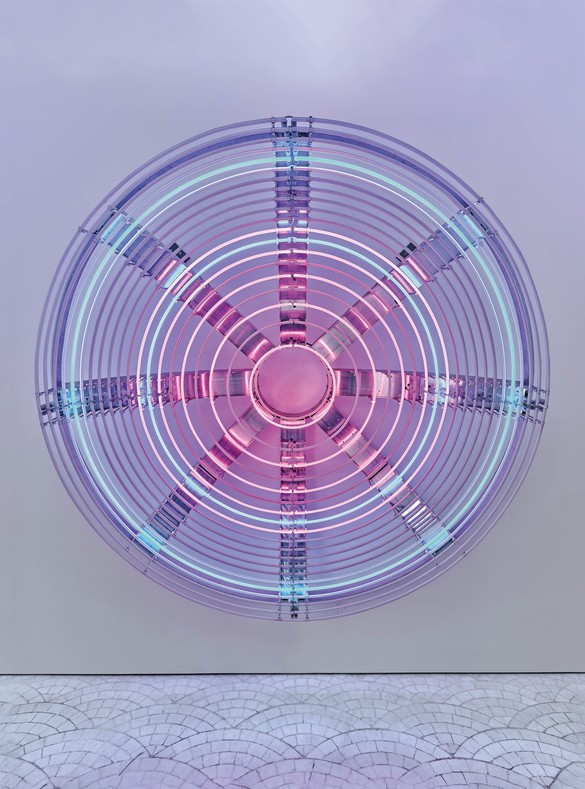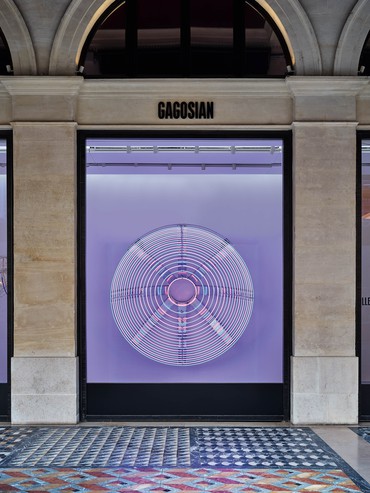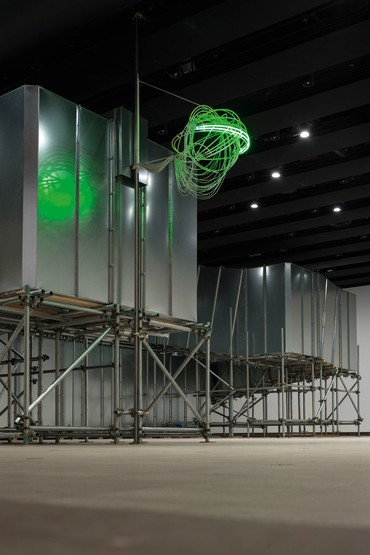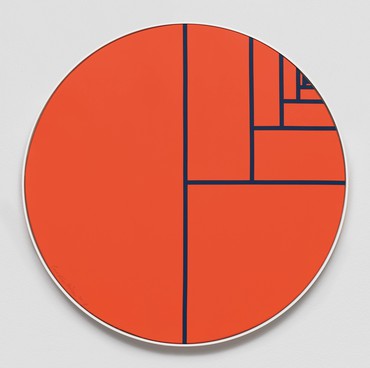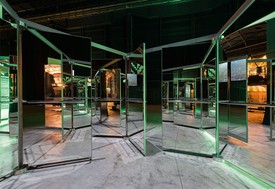
Federico Campagna is an Italian philosopher based in London. He is a fellow at the Warburg Institute and at the Royal Academy Schools, London, and a lecturer in intellectual history at ECAL, Lausanne. He is the author of Prophetic Culture (2021), Technic and Magic (2018), and The Last Night (2013). He is currently writing a book on the history of the Mediterranean imagination. He is the cofounder of the Italian philosophy publisher Timeo and a director at the UK/US publisher Verso.

Born in Brussels in 1961 to German parents, Carsten Höller lives and works in Stockholm, Sweden, and Biriwa, Ghana. Using his training as a scientist in his work as an artist, Höller concentrates particularly on the nature of human self-exploration. He has undertaken many projects that invite viewer participation and interaction while questioning human behavior, perception, and logic. Photo: Jamie-James Medina
Federico CampagnaCarsten, perhaps we could begin with your Decimal Clock [2023], which is calibrated to mark time according to a decimal system of tens, as was originally proposed during the French Revolution. One of the things I collect, when I have a little bit of money, is books from the French Revolution that utilize the revolutionary calendar and time-keeping systems they sought to impose.
Carsten HöllerSo you have a little library already?
FCVery small.
CHLike three books?
FCYeah, something like that. Five.
CHOkay. Five. They’re expensive, I assume. So you know a lot about the decimal clock. It always struck me as a great idea. If you compare the metric system to other measuring systems, you think, Why are some people holding onto something very complicated? The idea of measuring time in a different, more pragmatic way, in terms of ten hours instead of twenty-four, with a hundred minutes and a hundred seconds each—decimal time is a very good idea. But—and it’s a big but—if you want to implement it, it needs societal backing. It’s like money in that it requires a common agreement, now on a global scale. But they did reorient the measurement of time during the French Revolution. They started with a new calendar and a new way of measuring time on a daily basis, or on a second basis, if you want. And from what I know, it ended in utter chaos.
FCYeah, mostly because counting on bases six and twelve has a long tradition. I think the difficulty lies in the fact that you’re trying to insert your new measuring of time within a tradition that also makes sense, and it makes sense exactly because measuring time is such an arbitrary decision. Apart from the technical problems of dividing in base ten, for general use, to continue believing in something as implausible as time, you need to have a big investment of belief. And the suspension of disbelief is aided by the fact that people are encouraged by the idea that it’s part of a long tradition—this tradition of societies counting in base six goes back to the Babylonians. As we know in politics, for example, to make people believe in implausible ideas, like “nation” or “time,” linking back to an old tradition stretching back seemingly to the infinite makes an impact.
CHStrangely, when it comes to food at least, the twelve unit only persists with oysters and eggs, which are both very soft—
FCAnd roses.
CHAnd roses too? I don’t know, I never buy roses. I don’t like the idea of looking at dying flowers. But that’s another story.
Softness in eggs, oysters, and time—there’s an interesting cohesion for twelve. But getting there strikes me as mysterious. Time is a concept, yes, but on a larger scale it’s based on the rotation of the earth around the sun, the rotation of the moon around the earth. So we have a calendar that’s seasonal—you need that to calculate for agriculture, when you put your seeds in the soil in order to make the crop grow, and so forth. But when it comes to defining a smaller unit of time than a season, in terms of hours or minutes or seconds, then it becomes implausible, as you said. So why do we need this? Do you think this time—beyond seasonal or planetary time—really exists at all?
I think there’s also something you could call evolutionary time, something that, because of a process that’s been going on over a long period, is creating change in many different forms. Then there’s also biological time, which I find very interesting because it’s the only real time I think we have and we don’t even know what it is.
FCThe problem of whether time is real is a very ancient problem. Saint Augustine used to say, Time is the thing that I know what it is as long as you don’t ask me. The second you ask me, I no longer know what it is. Which I think is spot on. Time refers to change. Going back to the ground zero of the meaning of the term, it refers to change plus observation of change. The fact that there is, to a certain extent at least, visible change, this is something we can say is real. It’s real that we can observe transformations. Now, how much reality or value do we want to give to these transformations is one initial problem, and how much do we want to give to our observation is the second problem. We can disprove both these parts. If we do, then we start really putting time to the side.
What’s the problem with the reality of change? We can see that there are many changes, but we can question whether these changes are substantial or just accidental, cosmetic, illusory. Many philosophers see them as illusory, of course. Gregory Palamas, a Byzantine theologian of the fourteenth century, made a distinction between two aspects of God. One is the essence of God, the ousia, which is invisible and we don’t see it. One is the energy of God, the energeia, which consists of visible transformations. The world is one of these energies. Now God has to be located in both parts, but let’s say the fundamental part is the ousia, the essence, the unchanging one, the eternal one. So if we focus on change, we’re focusing on the illusory aspect, not in the sense that it’s false but in the sense that it has no substantial reality. You find a similar intuition in Buddhism, of course, especially in Chan Buddhism, where one must consider both aspects but appreciate that the aspect of change is not substantially important. You cannot rest your case on it.
We could say in a sense that what we have is a reality that in itself is outside of time. But this unchanging, eternal reality, it’s as if it were constantly—since you were talking about food—digesting itself. And this infinite process of self-digestion is change. We can observe this change, and notice regularities in this process of endless digestion of reality, and on the basis of these regularities we can try to find a certain rhythm. From there we slowly move toward the idea of meaning. The observation of these changes, and the counting of these changes as we observe them, that’s what we call time. And you see that at this point we’re far removed from the ground zero of reality. We’re so many layers removed that we’re talking about a matter of administration of our lives rather than a matter of metaphysics.
CHYou speak about something outside of change. I don’t really understand what you mean by that, because it seems to me that change is the only constant factor we can absolutely rely on. Nothing can evade change. Just like time, there’s no way out of it. Or do you think there’s a way of stepping out of time? Can you somehow break this dominance and this hierarchy of something you’re subjected to—because it’s not really you who’s deciding about the change you then call time, but it’s something you have to deal with. To go back to the idea of biological time in terms of a biological clock, there’s some kind of internal mechanism, something that counts time because it has to make you die at some point. At some point—not yet for you, as far as I can see—it makes your hair gray. It’s an active process. Genes have been counting time inside your body to the moment when you start this peculiar aging process, which means that at a given moment in time, you have to die. This seems to be common to all forms of life. So this connection between time and being alive, isn’t that the main thing?
FCYou bring up many interesting things. I’d like to start from the beginning, though: how can there be anything unchanging if change seems to be the only sure thing? Now, thinking logically, if we have something that exists and that undergoes endless transformations, then the transformations might continuously modify the shape of what there is. That thing never has the same shape, the same form, but it’s constantly there, so there’s a continuum of existence through change. Existence itself, which in a sense is the most important thing, is what keeps us all up, and it’s unchanging. Just as, in order to have observation, you need to have an observer at a distance from the object being observed to a certain extent, to have transformation you need a substratum, an unchanging ground. So, paradoxically, change is only made possible by the fact that there’s a bedrock that doesn’t change. So there is, in a sense, something that’s already outside of time, and we find it precisely at the heart of what changes.
In reference to the later questions, when you were talking about biological time, of course we see, for example, that organisms that are these conglomerates of matter are conglomerates of change. I agree with you there: what we fantasize as stable matter is in fact in constant change. It’s a constant fluid. But this fluid tries to create patterns. The particular pattern that is me has a certain regularity, it seems, more or less, that makes me undergo certain transformations. And inasmuch as I can observe it, okay, I can see that this begins being observable at a certain point and then stops being observable as that thing at another point, like the beginning of life and the end of life. It’s also related to memory: what we say is that our biological life is a series of changes and transformations as we observe them, as we catalogue them, as we define them. Do we really want to assign to that pattern the word “life”? It’s an arbitrary decision that we put together the term “life” and the term “biology.” But I think we might be missing something: that thing in me that observes these transformations is alive, equally alive as the rest of the body. That thing being capable of observing is also separate. Then it’s somehow part of life, but being separate is outside of time. Do you see what I mean?
CHI don’t agree. But go on.
FCLimiting the definition of life simply to the pattern of biological changes might be hindering in the sense that we’re assigning the term “life” to something accidental and not substantial.
CHIf there’s only planetary movements around the sun, and there’s maybe only change but no time, then what this implies is that you have time as a circular movement, not as a linear thing that progresses. If so, then I don’t think you can really step out of it. If it’s a circular thing, it’s not really change in the end. It’s just endless repetition of an infinite number of possibilities. It just goes around and around and around and it never gets anywhere. So in that sense, maybe the biological clock is the only clock that really counts; it’s the thing that makes us come and go, appear, disappear.
FCYes. I mean, the biological clock, a clock that basically sets the pace for your movement toward death—that clock is fundamental. That was also, for example, Heidegger’s way of understanding time. In Heidegger, the idea is that you live an authentic life, as opposed to an inauthentic one, when you realize that as long as a person is born, he’s old enough to die. All creatures are thrown toward death, but human beings are the only ones who are aware of this. And we have to understand time as measuring the distance toward this event of death, which could come at any moment. But I would contend, once again, that even the case of how we understand that in Heidegger is very similar to the idea of measuring time toward eternity, because the event of death is also an event at which you’re not present. It’s an event that is somehow outside of your immediate experience. It’s detached from you.
With all these things you were mentioning, all the different types of time, I’d say that technically they’re just observation of changes. So you’re measuring changes, then you’re observing them, then you’re tracing patterns, and then you’re giving a value judgment to your observations—you’re saying my observations are, first, correct, second, real, and important in that they say something. But you know, the degrees of mental pathology are assigned in relation to the extent to which you give importance to patterns. When you give too much importance to identifying patterns everywhere, that’s pareidolia, which goes toward schizophrenia and is considered a form of pathology.
The fear of free time and then the necessity of filling it with fun—I’ll say clearly that I’m against fun—is a remarkable phenomenon.
Carsten Höller
But you can also decide to go to the other side and give no importance to patterns whatsoever, and to simply say, I have these observations, sometimes I see these patterns, but they count for nothing. And that’s mysticism. So what I’d suggest is that you can decide to what extent you want to assign importance to these observations. It might be limiting to somehow identify the fantasy or ghost of life, which is a concept we hold very important, with certain pattern recognitions. We can do it, there’s nothing against it, but we can also not do it, and that would be equivalent. Do you see what I mean? I think concentrating on the unchanging aspect rather than on the changing aspect has a strong practical value: It makes you focus on the fact that you can continue observing this change while controlling your emotional reaction to your observations.
It’s very similar with psychedelics: you observe changes that are outside your control. Sometimes they seem to have patterns or tendencies, and some of these tendencies may seem terrifying; and at that point the challenge is to try to observe them and not lose your well-being. It’s like a meditation: you need to detach yourself, at least metaphysically. You can do this by identifying with the aspect of eternity rather than with the aspect of time.
CHAlso with psychedelics, they show you that the perception of time is mutable. We think our perception of time is something that happens while we’re awake, but it’s not really true, because even when we wake up after sleep, we know roughly if it was a long sleep or a short one. But psychedelics can dramatically alter that perception, which is revealing about the flexibility of our experience of time. 5-MeO-DMT, which is a psychedelic found in plants and in a toad—the whole experience is fifteen minutes or so, but it’s very, very, very strong, it blows you away: it makes you perceive those minutes as hours, if not days, or even some kind of glimpse of eternity, which is remarkable because normally that experience would mean pathology is lurking. It’s really an excursion into a pathological state of mind that’s unable to deal with time anymore, and gets out of it. And once you’re out of it, you’re really lost, because you lose all functional ability. A way to measure time also is a way of getting a grasp on life in some way.
Here I think we can make an interesting turn to your book Prophetic Culture [2021], where you speak about the necessity of dividing things into units. If you just perceive the world as a big continuous whole, a big ever-changing whole, you won’t be able to relate to it, you won’t be able to understand anything.
FCWhat you were saying about the perception of time, and its shifting through the use of psychedelics, is key. I think those chemicals give you an immediate sense of to what extent time is a function of attention: depending on how you exert your attention, then somehow time seems to be stretching around it. It’s as if attention were equivalent to what in physics is the gravitational pull. At a point of high gravitational pull, time moves very fast, while outside only five minutes seem to have passed.
This is connected to the necessity of dividing. We tend to have this immediate—it seems almost automatic—tendency toward dividing what’s around us. What is around us approaches us as indistinct, even just visually. The image that you see of the room around you is indistinct. It’s one image, but then you divide it into many different, discrete elements, each of which has certain qualities, a particular name and way you interact with it. This is how we’re able to functionalize the space around us. The ground zero of our perception is not like that. The ground zero is simply there is one.
The risk with psychedelics sometimes, of course, is that if you take them with a wrong attitude, that experience can be hell, you know? So eternity can be home or a terrifying place where you’re lost. For mystics, usually the world of time is defined as a foreign land, so that you live inside time as if you were a foreigner in a foreign land. Hugh of Saint Victor, or Saint Paul in the first letter to the Corinthians, writes that we have to live in the world as if we weren’t there. We’re resident aliens, in that common phrase. So home is eternity. Home is the dissolution of everything.
Time is the function of all these things. So how we direct our attention, how we invest our belief toward our observations, and how we judge them as relevant, plus to what extent we invest our attention and our belief in the coincidence of this particular pattern with associated social life, creates many different variations. (One reason we divide is to maintain a social life; we must somehow be able to identify each other as distinct individual units, and then everything follows from there.) If you pull some of these levers, time starts to bend until it shatters. If you pull them up to the maximum, then time becomes a real prison, which is precisely what late-capitalist society does. Late-capitalist society is very high on self-identification, on identity, on cataloguing, on associated social life as something that if you get out of it, you’re destroyed. There’s zero belief in eternity. And then time becomes what the American philosopher Jonathan Crary calls the twenty-four/seven hellscape, a constant function that goes together with constant division, constant engineering of everything.
CHGetting over this divisional aspect of understanding is one thing that’s been attempted in many different ways through the course of human culture. But there’s another way I’d be interested to hear your opinion about, which is that you do the opposite. You take the object, so to say—whatever you’re looking at, or thinking about, or measuring—and you go on dividing this thing into smaller units until in principle—in mathematical terms it’s not really possible, but in philosophical terms it would maybe be possible—you divide it and divide it and divide it again until nothing is left, which would happen in infinity. Then you would have a similar result as the undivided route. I’ve been using this principle quite a lot, for instance in the Division Paintings series.
FCWe can get to the same place via two completely alternative routes. I have to say I prefer a mystical route, going toward this idea of existence as an infinite eternal void. But if we go the other way, if we have the contemporary hyperspeed and we push it to the extreme, we accelerate to the maximum, we get to the same position the other way. You can enter it from two ways; it’s the same room, but how you inhabit it is very very different. Nihilism and mysticism are very close, but they’re categorically different.
CHIt’s always the same pattern. You go to the extremes and then you meet again.
FCAnd then you meet again—but you don’t meet again. That’s the difference, though. Entering infinity through the angle of nihilism by accelerating, dividing to the extreme and finding nothing, is very different from the other way, in which you find the root of existence.
CHWhy is that so? I understand what you’re saying, but is it a qualitative difference or is it really just a division in space, so to say?
FCIt’s a qualitative difference. If we’re talking about time, we’re touching one of the roots of metaphysics in general. There are very few things that we can say for certain exist. One of those things is existence itself. Another is our awareness, because we are it: we exist and we are aware. That’s all we know. And the third category we can say for certain exists is pleasure and pain, joy and suffering. In Buddhism, the noble truths recognize the ontological existence of suffering. So whether something is approached in a way that enhances suffering or whether something is approached in a way that brings suffering down and enhances joy is not just a matter of “stiff upper lip” and “suffer through it.” It’s the fact that we’re touching one of the ontological components of reality.
And then it’s a qualitative decision whether we want to go down the route of maximization of pain. We can accelerate the rhythm of our production infinitely, and basically destroy ourselves through the route of a suicidal kind of acceleration of time and infinite identification with names, with languages, with society, with division. It will be a route of infinite suffering. And since we’re talking about one of the few things that we know exists in reality, we have to be careful how we handle it. I’d suggest qualitatively to take the other path, the one that goes toward the eradication of suffering, which, by the way, is the basis of not only Buddhism but many aspects of other Indian religions.
CHI’m not a philosopher, but our decision-making in principle is mainly based on the avoidance of pain, which we have been actually quite successful at, if you think about it. If you compare how we lived in former times with how we live now, the avoidance of pain has become a stronger motivation—the avoidance of pain and the maximization of fun. Wouldn’t it be good enough to say, you know, we need neither pain nor fun, we can live perfectly well without them? We don’t need the pleasure principle as something governing all our lives, we can just organize ourselves and get our things done and try to find something in the middle unlinked to these emotional states.
FCIn Latin, you would say the aurea mediocritas, the golden mean. But that is epicureanism, and this is something worth considering. At some point in the ancient Mediterranean, you had a very developed society with a lot of poor people on the margins. Inside there was a lot of wealth, but political action was completely out of possibility for everyone; you basically had a situation like ours today, a constant militarization. In that world, philosophy moved away from metaphysical speculation to the problem of how we live, how we deal with suffering, and they generated many different solutions, such as stoicism and aspects of cynicism and epicureanism. And that was fantastic because then, philosophy was self-help in the best meaning of the word. Basically it was the equivalent of psychotherapy, mathematics, and philosophy today, but all combined in one. The problem was exactly what you were mentioning: how do we deal with suffering? And the solution was what you mentioned: in a sense, it’s not detaching ourselves completely, denying the reality of the physical world, of changes and transformations in the patterns that we recognize and so on and so forth, but rather regulating how much we want to attach ourselves to them. We need to avoid the pit of desperation in which we attach ourselves to something so much that when we lose it, we’re destroyed, the peak of gluttony. Epicurus himself, for example, used to say that his happiness was a glass of water and a piece of cheese, but not too much cheese.
Today the problem is that we don’t seem to be considering the aspect of suffering seriously enough, in a way.
CHWhy is this collective recognition of suffering not happening? Is it something that we don’t see or—because it’s very obvious, no? Why aren’t we able to focus? It’s like we’re all busy with so many different things at the same time, and if we get something done, we begin three more things to get even busier. The fear of free time and then the necessity of filling it with fun—I’ll say clearly that I’m against fun—is a remarkable phenomenon.
FCI think the way we’re acting today makes sense in relation to a particular idea of reality and of our life. This crazy continuous attempt to expand our life, to live until we’re 120 . . . the fact that you never retire, that you work every day of your life, that you’re impoverished, paying rent every day, that doesn’t matter. It’s going to be a shit life, but the important thing is that it’s as long as possible. This makes sense through the idea that basically life, reality, is just a thin crust over an abyss of nothingness in the hellish sense. And the point is that we’re trying to sustain this crust, which is constantly breaking so we infinitely have to mend it. And this is a very anxious feeling. It’s like certain forms of self-care, such as training and the gym. Some people have this relationship with their body—they want to go beyond the process of aging, as if they were constantly trying to mend this rotting fabric. That reflects a particular belief that what’s outside, beyond time, beyond the world, beyond the identification, is not something, it’s nothingness. It’s a devouring monster, like Apophis in Egyptian mythology, the big snake that devours all the worlds.
Another way to farm time more intensively, to focus it differently, is to believe—and once again, this is just a belief—that what surrounds our time is not this devouring monster that we must constantly fend off, at the cost of renouncing the pleasure of life, but something else, and that something is fundamentally the thing that is holding you up. The difference is everything. You don’t change the condition of reality—reality remains as it is, whatever we think of it—but you completely change the experience of life. You have it in Sufism, the idea that there’s always one person in the world who is basically a saint, and that person is holding up the world with his or her own enlightenment. The enlightenment of this person living in hiding is sustaining everyone, but nobody perceives it. In order to farm time differently, it’s not enough to restructure society, because then you try to impose on it, police it, which is not only ethically wrong but just doesn’t work. The French Revolution, for example, worked so-so, and actually failed precisely because it failed to do that. You need to modify the metaphysical.
Carsten Höller: Clocks, Gagosian, rue de Castiglione, Paris, March 28–May 20, 2023
Artwork © Carsten Höller
